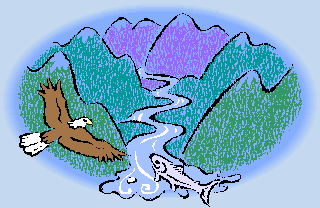Water News for July 2012
While you were vacationing or wishing you were, a lot of important things happened in the interesting world of water. Read on to hear all about it.
The Coral Reefs in Our Oceans Are Mere Zombies That Will Be Gone Within a Human Generation
Overfishing, ocean acidification and pollution are pushing coral reefs into oblivion. Each of those forces alone is fully capable of causing the global collapse of coral reefs; together, they assure it. The scientific evidence for this is compelling and unequivocal, but there seems to be a collective reluctance to accept the logical conclusion — that there is no hope of saving the global coral reef ecosystem.
What we hear instead is an airbrushed view of the crisis — a view endorsed by coral reef scientists, amplified by environmentalists and accepted by governments. Coral reefs, like rain forests, are a symbol of biodiversity. And, like rain forests, they are portrayed as existentially threatened — but salvageable. The message is: “There is yet hope.” –Roger Bradbury
This is the opinion of Australian Roger Bradbury, expressed in a New York Times op ed piece. According to Mr. Bradbury, coral reefs now are living only a zombie existence and within a human generation, “There will be remnants here and there, but the global coral reef ecosystem — with its storehouse of biodiversity and fisheries supporting millions of the world’s poor — will cease to be.”
Bradbury's description of the ocean of the future isn't appealing:
What we will be left with is an algal-dominated hard ocean bottom, as the remains of the limestone reefs slowly break up, with lots of microbial life soaking up the sun’s energy by photosynthesis, few fish but lots of jellyfish grazing on the microbes. It will be slimy and look a lot like the ecosystems of the Precambrian era, which ended more than 500 million years ago and well before fish evolved.
Bradbury believes that we are wasting valuable time and resources in an effort to save a corpse and that we should instead be focusing on how to live without coral reefs.
Please read the full article from the New York Times.
Global Water Treatment Chemicals Market to Cross US $31 Billion by 2017 Says TechSci Research
According to a recently published report by TechSci Research “Global Water Treatment Chemicals Market Forecast & Opportunities, 2017,” the water treatment chemicals market will surpass $31 billion by 2017,
This is due to the increasing fresh water demand from consumers and industries along with increasing demands to clean up waste water.
According to the report, the demand for treatment chemicals is certain to grow enormously in the near future.
The research firm divides treatment chemicals into six very profitable segments: “Coagulants and Flocculants which accounts for maximum demand globally followed by Biocides and Disinfectant. These two segments alone accounts for more than 60% revenues from water treatment chemicals business. The other segments in water treatment chemicals market are Inhibitors, Defoamers & Defoaming agents, pH adjusters & softeners. By 2017, it is anticipated that highest growth will be witnessed in pH adjusters and softeners market which will growth with compounded annual growth rate (CAGR) of more than 4%.”
Whether this is good news or bad depends on one’s perspective.
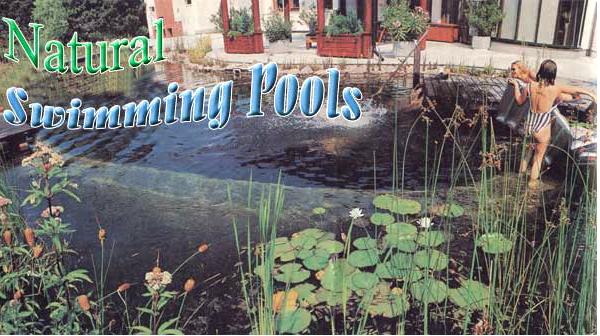 |
| Swimming Pools Don't Have To Smell Like Bleach |
Chlorine Doesn’t Have To Be Part of Swimming
Chlorination is the standard way of keeping swimming pools free of bacteria, algae, and excessive turbidity. For a number of years, however, there have been alternative technologies. Each has its pros and cons.
Here are some pool alternatives you might want to explore if you have or plan to have a home swimming pool.
1. Saltwater: A saltwater pool system uses sodium chloride in a naturally occurring cycle to keep your pool clean. Chlorine is present, due to the off-gassing of the salt, but it’s far less than in a conventional chlorine pool.
2. Ionizer: An ionizer (so called) uses the mild antibacterial properties of copper and sometimes silver ions to keep your pool clean. Little if any chlorine has to be used.
3. UV/Ozonation: Ultraviolet can be used to keep bacteria down, or UV can also be used to generate ozone to disinfect the pool. A small amount of chlorine will probably be needed to provide a residual disinfectant.
4. Sonic cleaning: Using a machine that produces ultrasonic waves in the water, algae is destroyed at a cellular level.
5. Ecosystem: You can have a totally natural pool by using plants and a breathable bottom. According to MotherEarthNews.com, a pool can be constructed for as little as $2,000 if you do it yourself, while conventional pools can cost tens of thousands of dollars.
More Information About Chlorine-Free Pools
”Stop the Frack Attack” Rally Took Place in Washington D. C. on July 28, 2012
On Saturday, July 28th, more than 5,000 people rallied on the West Lawn of the Capitol in Washington, DC, and then marched through the streets of DC as part of the Stop the Frack Attack Rally.
Full Details
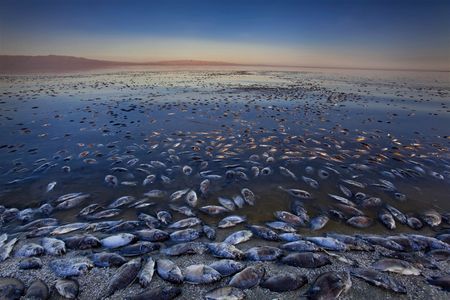 |
Dead tilapia float in the Salton Sea near Salton Sea Beach, California in January 2011. Erosion and high toxicity levels from farm runoff have left the Salton Sea increasingly contaminated, causing massive fish die-offs, and lake-side towns to become all but deserted.
Read more in the Pure Water Gazette.
Larger Image |
Water Does Not Necessarily Cost More in Areas Where It Is Scarce. Seattle Tops the List of Ten Cities with the Costliest Water.
According to information from the Waterless Company, how much we pay for water in the U.S. can vary significantly depending on where we live. Further, there is not necessarily a correlation between water costs and where “water rich” and “water poor” cities are located.
For instance, based on using 7,500 gal of water per month, a family in Seattle, Wash., has the highest water rates in the country at $56.18. However, the city has experienced relatively adequate, normal rainfall over the past five years.
Conversely, residents of San Antonio, Texas, pay less than half this amount, $22.80, for the same allocation of water. Yet over the past five years, San Antonio has experienced drought conditions 80% of the time.
Read on to find out which cities have the costliest water.
 |
A monster white sturgeon weighing an estimated 1,100 pounds and measuring 12 feet, 4 inches was caught and released on the Fraser River, a British Columbia waterway famous for its big sturgeon. It is believed to be the largest and possibly the oldest (100 years plus) fresh water fish ever caught on a rod and reel. More details in the Pure Water Gazette. |
A Gray Water System Can Save Water, But It Can Also Be A Lot of Trouble–A Lot More Than Simple Conservation
by Hardly Waite
There was a time when talk of collecting and reusing “gray water” was strictly the province of hippies and readers of the Mother Earth News. With the increasing scarcity of water, we now hear more about it from a wider spectrum of the population.
In general, gray water refers to water that goes down the drains of bathroom sinks, showers, tubs, and clothes washers. Black water, by contrast, is the waste from kitchen sinks, dishwashers, and toilets.
With proper in-home treatment, gray water can be reused. Black water can be reused only if treated by a municipal waste water system. Treated gray water can be used to flush toilets and for irrigation, under certain conditions. It is recommended, for example, that gray water not be reused through sprinkler heads.
The point is, reuse of gray water is limited. It also requires significant plumbing modification on existing homes. (It is much easier to arrange when a home is being built.) Maintenance requirements can also be significant.
While gray water use can save water, much more can be saved by landscaping for low water requirements.
The Gazette’s opinion is that the first step in really progressive water management in the home is tossing out the 1950s notion that your moral obligation as an American is to grow and mow as much grass as possible.
More About the Pros and Cons of Gray Water
Water News of the Month
Here are a month's worth of water stories from the Pure Water Gazette's "Today's Top Water News" feature. Some are referenced in this issue.
 |
How Undersink Reverse Osmosis Works
by Pure Water Annie
It's a Lot Simpler Than You Think
|
The drawing below is a standard 3-stage Pure Water Products Black and White undersink reverse osmosis unit. "Three stage" means that it has three main treatment devices--in this case, two carbon block filters and a reverse osmosis membrane. Four stage units usually add a sediment prefilter.
Here's a step-by-step rundown of how it operates.
1. Pretreatment. Tap water taken from the cold water undersink faucet pipe enters the Prefilter (Inlet) port through the quick connect fitting just below the Prefilter (Inlet) label. The vertical prefilter canister contains a high quality carbon block filter which removes chlorine/chloramine and other miscellaneous chemicals. The filter protects the reverse osmosis membrane from disinfectants.
2. Shut-off system. Treated water exits the back of the prefilter canister via a 1/4" tube which loops its way to the top of the unit where it enters the Auto Shutoff valve. The Shutoff Valve is the round device clipped to the top of the horizontal membrane housing. In the Shutoff valve the water makes a horseshoe turn and exits through the 1/4" tube that takes it to the right end of the Membrane housing. [More of the shutoff system and what it does later.]
3. The Membrane. The reverse osmosis membrane is contained in the horizontal housing labeled Membrane. Its function is to screen out hard to remove contaminants like fluoride, lead, arsenic, chromium, nitrates and others as well as make a 90% plus reduction in the "dissolved solids" like sodium in the water. The membrane separates the water it treats into two streams--the product water (permeate) and the drain water (brine).
4. The Drain Water. The stream of drain water, called the brine or concentrate, contains the concentrated minerals and metals that are rejected. The reject water goes out the "drain line" at the extreme left of the unit. The drain line connects to a special clamp called a drain saddle that is installed on the undersink drain. The two cigar-shaped items in the drain line are a flow restrictor (above) and a check valve. The flow restrictor controls how much water flows to drain. It limits the drain flow to a tiny stream that is sized to suit the drain flow needs of the membrane. The other device, the check-valve, is a one-way valve. It allows water to flow toward the drain pipe but prevents it from flowing backward toward the RO membrane. Its function is to prevent backflow into the RO unit in the event of a blocked drain pipe. [Note: Most RO units do not have a drain line check valve and the flow restrictor is a much smaller part that is built into the fitting that connects the drain line to the membrane housing. Also, an air gap faucet can be used instead of the drain line check valve.]
5. The Product Water. The product water, the water you're going to drink, is often called "permeate." It leaves the left end of the membrane housing via the tube next to the drain line, passes through a check valve, and enters the left side of the Auto Shutoff valve. The function of the check valve is to keep back pressure from the unit's storage tank from pushing water backward into the membrane canister. This small check valve is essential for proper operation of the unit. [Instead of the external check valve in the picture, most RO makers use a tiny check valve that installs into the fitting at the point where the product water leaves the membrane canister.]
6. The Shut-off system revisited. As described above, the filtered tap water passes through the right side of the shutoff valve on its way to the membrane. On the other side of the shutoff valve, the permeate (product) water makes a horseshoe pass through the left side of the shutoff valve on its way to the Tank Line tee.
7. The Tank Tee. The tank tee serves as a fork in the road. Water takes the path of least resistance, and when it comes to the tank tee it goes to the pressure tank or to the inlet in back of the post filter, whichever offers less back pressure. The tube that joins the tee and the storage tank serves as both entry to the tank and exit from it. Depending on where pressure is greatest, water flows into the storage tank or back toward the tank tee.
8. The Storage Tank. A storage tank is needed because the reverse osmosis membrane processes water slowly, at the rate of a fast drip or a tiny stream. The tank is pressurized with a light air charge. Water is collected in a flexible bladder inside the storage tank and is pushed out by air pressure when there is a demand for water.
9. The Post Filter. The final filter is connected to the dispensing spigot on the sink top with a single 1/4" tube that plugs into the the Post Filter (Outlet) fitting. The Post Filter is a high quality carbon block filter that removes any remaining chemical traces and polishes the taste when water passes through it on its way to the spigot.
10. The Delivery and Shut-Off System. When the spigot on the sink is closed and the unit is making water, the product water has no place to go but into the storage tank. As the tank fills, it exerts increasing back pressure on the left side of the shutoff valve. When pressure in the tank reaches about 2/3 the incoming water pressure on the right side of the shutoff valve, the mounting pressure closes a piston inside the shutoff valve that stops water from entering the membrane. The unit remains off until a demand for water (opening the spigot) releases pressure on the left side of the shutoff valve. When the spigot is open, water leaves the tank, goes through the tank tee, through the post filter, and out the spigot. When the spigot is closed, the unit slowly refills the tank until back pressure from the tank again shuts off water to the membrane.
 |
Numerical Wizard B. Bea Sharper ferrets out the watery facts that Harper's misses
|
Facts You Would Have Learned from This Issue Had You Been Paying Attention
Weight of a giant sturgeon caught and released recently in the Fraser River -- 1,100 pounds.
Rank of Boston among the US cities with the highest priced water -- 2.
Year in which the Salton Sea was created by flooding of the Colorado River -- 1905.
Percentage by which the Salton Sea's salinity increases each year -- 1%.
Predicted revenue of the water treatment chemicals industry by the year 2017 -- $31 billion.
Number of stages in a three stage reverse osmosis unit -- 3.
Number of dead tilapia fish in the Salton Sea photo in this issue -- 38,673.
Number of people who participated in the July 28, 2012 anti-fracking rally in Washington, D.C. --5,000.
Featured Product from Pure Water Products
One of our best but least advertised products is a basic four-stage undersink reverse osmosis unit that we sell under the unpretentious name of "Economy Reverse Osmosis." It's the only RO unit that we sell that we don't build ourselves. The "Economy" unit is a sturdy conventional 4-stage unit (sediment, carbon block, 50 gallon-per-day TFC membrane, and granular carbon inline polishing filter).
We've sold many of these over the years and customer satisfaction is very high. The Economy is a credible unit that will provide many years of superb water at a low initial price and low upkeep. The quality of the product water is exceptional.
The unit is built by Watts, and all the parts are standard. (Nothing proprietary that you won't be able to get a replacement for.) We've put together an annual replacement filter pack for the unit that costs less than $40.
Total Price for the Economy RO Unit -- $235. We pay shipping.
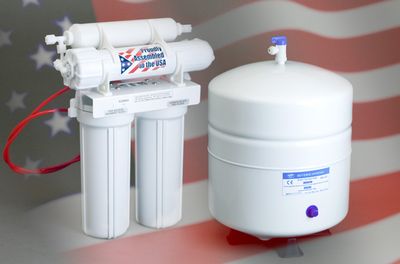 |
Larger Image
The four-stage unit and metal storage tank. (Flag not included.) |
The Economy RO comes with a complete accessory pack--everything you need for a complete undersink installation.
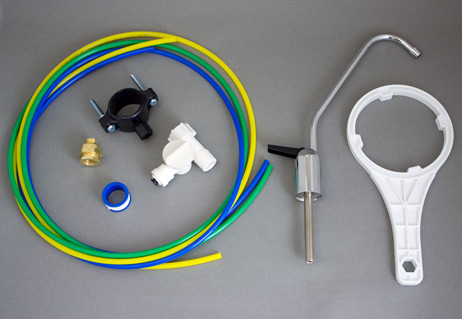 |
| Color coded tubing makes installation easy. The Watts lead-free ledge faucet has a stainless steel stem. |
Pure Water Gazette Now in a New Format
Our information-stuffed variety magazine, the Pure Water Gazette, has taken another turn. The Gazette started as a paper publication in the 1980s. The last paper issue was mailed in 1997. It has existed since as an information-rich website whose navigation and aesthetic properties were suffering from years from neglect. Although the old site can still be seen here, the best of the old content has been relocated to a much more manageable blog-style format. The new site is up and running as a work in progress with over 300 articles and many more to come. At least one new article is added each day. The new site is at the old location, http://www.purewatergazette.net. Please visit!
|
